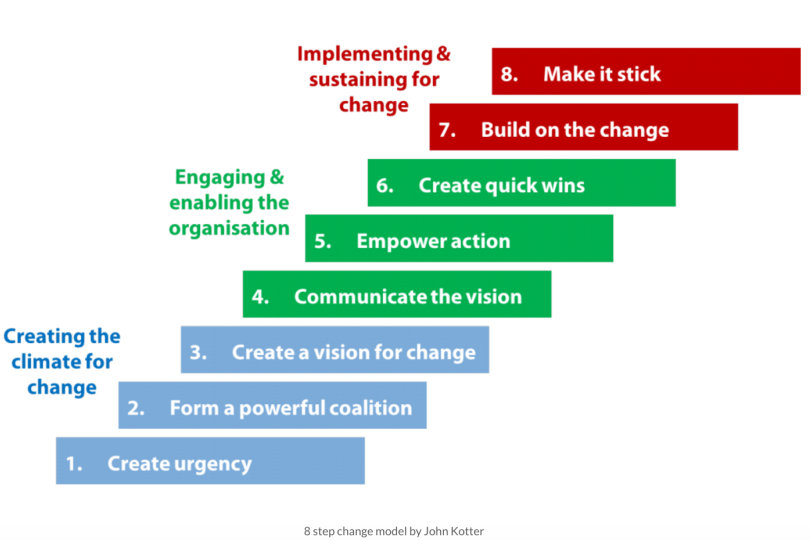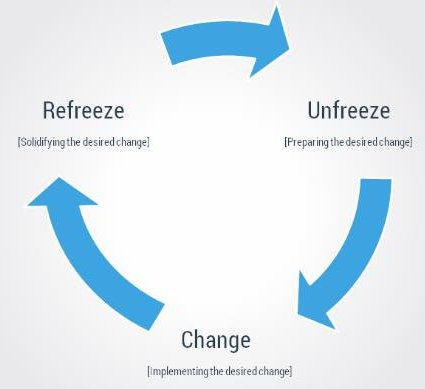It’s natural to view change with mixed feelings. Whilst many are uneasy about the idea, others relish the opportunity. Change management is unique within any organisation. Because of this, there exist countless change management tools to help both managers & Employees alike.
We’ll be looking at 7 key models and approaches to help you plan a winning strategy. But first, what is change management and how do we use it?

Understanding Change Management
Change Management as a term, can differ among others. It can be summed up in three different meanings, however, the most common way to define it is: As the use of methods & approaches in order to analyse and influence human behaviour.
Many of the change management tools are either academic, theoretical or conceptual, and aim to prevent change from disrupting the everyday business operations of an organisation.
Stakeholder Analysis
A critical step to the process of change management is stakeholder analysis. With this method, the object is to identify stakeholders, sorting them into different categories. There are a number of ways to categorise your stakeholders, such as from their influence or the impact they can have on a project.
Stakeholder analysis can be broken down into 3 steps:
1. Identify – Note all down of those that could be affected by the project. This includes recognising people who come from outside of your company.
2. Prioritise – Look at your list of stakeholders and prioritise them by their importance & influence on the project.
3. Categorise (Also known as stakeholder mapping) – Now that you have prioritised your stakeholders, designing a stakeholder map will display your stakeholders, their influence, markets, location and how they should be managed.
By the end of the analysis, you should know who your project’s stakeholders are and the importance of the project to them.
Kotter’s 8 Steps For Change
John Kotter’s 8-step change model is one of the well-known tools used to deal with organisational change. Often taught in business schools, this model provides helpful guidance to manage change on a large scale.
This tool is normally used when new technology systems are put in place, or establishing a digital transformation process. This model itself contains 8 steps which are:

1. Creating Urgency – We’re all guilty at one time or another of putting things off. Sometimes we need to be put out of our comfort zone in order to achieve results. Creating a sense of urgency helps increase motivation, as well as understanding that time is not on our side.
2. Forming a strong coalition – Installing influential people within your team is an important factor in organisational change. Having powerful stakeholders at the forefront aims to reinforce the need for change to the rest of the group. Goals can only be achieved if there is unity amongst stakeholders.
3. Developing a vision for change – Understand the values associated with change to build a strategy, thus helping to build your vision. Establishing clear and compelling visions for change helps your employees to recognise what you require from them.
4. Get your vision across clearly – Communication is vital to any team. Regular & clear communication can ensure that your goals are shared with the rest of your group. A mixture of face-to-face or one-to-one meetings and emails keeps dialogue flowing and helps monitor progress.
5. Clear any obstacles along the path – No matter how motivated we may be, there’s only so many obstacles we can manage to dodge. Taking time to identify and remove the barriers blocking change, ultimately help to maintain a smoother process.
6. Generate short-term wins – Whether short term or long-term, a win is a win and it’s always a good feeling. Putting all your eggs in one basket can have negative effects on confidence if a long-term goal fails. Start with quick wins, gradually building up the confidence and behaviours attached to change.
7. Building on changes – It’s quite easy to take your eye off the ball, overlooking the fact that the energy for change is running low. It’s important to find ways to reignite that spark and get everyone back on track. Reviewing regularly helps us learn from mistakes and build on previous successes.
8. Hold your strategies in place – Don’t let old habits die hard! A common insight on organisational change is that whilst it is effective at first, things can revert back to before if not kept in check.
Change Readiness Assessment Tool
A change readiness assessment tool provides you with snapshots of the current culture and behaviours within your organisation. It helps you to ensure your stakeholders are prepared for change. This involves surveying stakeholders from different levels to determine their acceptance of a proposed change. This identifies an array of information such as:
- Individual styles and behaviours
- Confidence in management and support
- Awareness of proposed change
- Organisational culture’s ability to remove barriers
- Communication skills
Culture mapping
Culture mapping is another handy change management tool. Every organisation will have its own way of operating and so will have its own values and behaviours. A culture map provides you with the data needed to execute change processes. This can allow you to identify positive enablers who pose a risk to change. There are three steps to culture mapping.
1. Identify the groups within your organisation and the subcultures they belong to. Find the people who represent them best.
2. Interview groups in order to find the employees reinforcing a resistance to change. It’s important to understand if this is intentional or not.
3. Organise the information found, to classify outcomes, behaviours, and resistors
Force Field Analysis
Force field analysis is a tool used to identify how change affects stakeholders, forcing you to consider the negatives of a proposed change. This can be done by brainstorming barriers and aids, collecting data from interviews, meetings and surveys. This helps you to understand what the forces are for and against change.
Lewin’s 3 stages
Developed by Kurt Lewin in the 1940s, this model describes the process of successful change in 3 stages. These are unfreeze, change and refreeze.

Stage 1 – Unfreeze
The focus of this stage is preparing to accept change. This is achieved by recognising that things can’t stay as they are and the need for change. We need to make sure employees are aware of the need for change as this will make it more likely for them to welcome it.
Stage 2 – Change
The transition into a change when an organisation transforms the way of doing things. This is the most difficult stage as it’s the moment in which the change becomes real. It’s crucial to educate, train, communicate and support your employees as we all have our own ways of adapting.
Stage 3 – Refreeze
We need to reinforce the changes in order to normalise them. Changes transform into organisational behaviours, processes or goals. When these changes are finally accepted, they are refrozen in order to become the new norm. Using positive reinforcement to reward or acknowledge employees is a great way to ensure changes are kept in place.
ADKAR
ADKAR is a coaching tool used in change management to ensure the employees involved agree and believe in the change. There are five key pillars that make up the ADKAR acronym:
- Awareness of the need to change
- Desire to support methods for change
- Knowledge about those involved and how they can make the change
- Ability for individuals to make the needed changes to their skills and behaviours
- Reinforce changes, preventing that things don’t reverse back to before
de Bono’s Six Thinking Hats technique
Edward de Bono’s six thinking hats technique is a simple tool used for brainstorming creative solutions to change within a group. The six thinking hats allow you to consider all factors, with each coloured hat representing different styles of thinking.
By mentally wearing these hats, switching them with the rest of your team allows you to share your thoughts and ideas easily.

White – Represents the information we have or need.
Black – The risks, weaknesses and problems faced.
Red – Discussing our thoughts and feelings about the changes.
Yellow – Exploring the positives & benefits of change.
Green – Generating ideas and alternatives.
Blue – Reviewing what we now know.
This tool can be used to help you and your employees set out goals before change, and share your thoughts and ideas to implement these goals.
Want to learn more about change management? Check out Applied Change’s free Change Management Guide which delves a little deeper into the tools models used.




